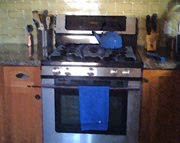Brown rice syrup is a natural sweetener that I have not used before. It makes an appearance in a number of recipes in Super Natural Cooking (written by one of my favorite bloggers, Heidi Swanson, author of 101cookbooks.com). While I love to cook from this book, I'd find myself either avoiding the brown rice syrup recipes or would replace it with another sweetener (maple syrup, agave nectar, honey). I was reminded of the existence of this product when I recently read The Kind Diet and decided it was time to both do a little research and give it at try.
Brown rice syrup is made by fermenting brown rice with enzymes that break down the starches, then straining the liquid and continuing to cook until reduced to desired consistency. Chemically, the syrup is a roughly 52-45-3 ratio of maltotrios to maltose to glucose (respectively), which means a couple of things. First, it is a polysaccharide, or complex sugar, that is broken down easily in the bloodstream. One site I read said that because it's absorbed easily, brown rice syrup leaves less "provision for fat accumulation. Sounds like a good thing to me! Secondly, brown rice syrup takes longer for our bodies to digest, meaning it doesn't cause the quick spike and subsequent plummet in blood sugar that most sugars do. The syrup is dark and gooey and, while certainly sweet, it is a mellower sweetness than you get from white sugar, maple syrup, or honey.
I've been eating the resulting granola all week: it's subtly sweet, nutty and crunchy. I've been enjoying it for breakfast with fresh berries and by the handful as a snack. I'd call my initial test of brown rice syrup a success. Here's what I did:
Rice-Sweetened Granola
3 c. rolled oats
2/3 c. almonds, roughly chopped
2/3 c. pumpkin seeds
1/4 c. coconut oil, melted
1/4 c. brown rice syrup
Heat oven to 350 degrees. Mix all ingredients thoroughly in 9x13 baking dish. Bake until golden brown, about 25 minutes, stirring every 5 minutes after the first 10 to ensure even browning.
1 year ago: simple salad
2 years ago: veggie veggie enchiladas

















